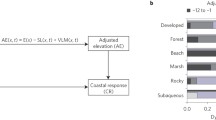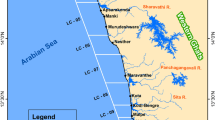Abstract
Sea-level rise involves increases in the coastal processes of inundation and erosion which are affected by a complex interplay of physical environmental parameters at the coast. Many assessments of coastal vulnerability to sea-level rise have been detailed and localised in extent. There is a need for regional assessment techniques which identify areas vulnerable to sea-level rise. Four physical environmental parameters – elevation, exposure, aspect and slope, are modeled on a regional scale for the Northern Spencer Gulf (NSG) study area using commonly available low-resolution elevation data of 10 m contour interval and GIS-based spatial modeling techniques. For comparison, the same parameters are modeled on a fine-scale for the False Bay area within the NSG using high-resolution elevation data. Physical environmental parameters on the two scales are statistically compared to coastal vulnerability classes as identified by Harvey et al. [1] using the Spearman rank-correlation test and stepwise linear regression. Coastal vulnerability is strongly correlated with elevation and exposure at both scales and this relationship is only slightly stronger for the high resolution False Bay data. The results of this study suggest that regional scale distributed coastal process modeling may be suitable as a “first cut” in assessing coastal vulnerability to sea-level rise in tide-dominated, sedimentary coastal regions. Distributed coastal process modeling provides a suitable basis for the assessment of coastal vulnerability to sea-level rise of sufficient accuracy for on-ground management and priority-setting on a regional scale.
Similar content being viewed by others
References
N. Harvey, T. Belperio, R.P. Bourman and B.A. Bryan, Asia Pac. J. Env. Dev. (in press).
Intergovernmental Panel on Climate Change, The seven steps to the assessment of the vulnerability of coastal areas to sea level rise, Response Strategies Working Group (1991).
G. O'Riain, The development of indices to coastal erosionutilising a GIS, Dissertation, University of Dublin, Trinity College (1996).
P. Cowell, T. Zeng, W. Henneckeand B. Thorn, in: Proceedings of the Australian Coastal Management Conference, ed. N. Harvey (The University of Adelaide, South Australia, 1996) pp. 185–193.
Intergovernmental Panel on Climate Change Working Group111, Second assessment report, Summary for policymakers: impacts, adaptation and mitigation options, Washington DC (1996).
Intergovernmental Panel on Climate Change, Strategies for adaption to sea level rise, The Netherlands(1990).
J.R. Eastman and S. Gold, Geo Info Systems 7 (1997) 38–43.
V. Gornitz, T.W. White and R.M. Cushman, in: Proceedings of Coastal Zone '91, Long Beach, California (8–12 July 1991) pp. 2354–2368.
M. Han, Acta Geogr. Sinica 49 (1994) 107–116.
S. Emani, S.J. Batick, G.E. Clarke, K. Dow, J.X. Kasperson, R.E. Kasperson, S. Moser, H.E. Schwarz, in: Proceedings of GIS/LIS '93, Minneapolis (2–4 November 1993) p. 201.
B.P. Jallow, M.K.A. Barrow and S.P. Leatherman, ClimateResearch 6 (1996) 165–177.
Shennen, in: Climate and Sea-Level Change, eds. R.A. Warrick, E.M. Barrow and T.M.L. Wigley (Cambridge University Press, 1993) pp. 215–228.
F.A. Hameed and M. Morad, Asia Pac. J. Env. Dev. 2 (1995) 25–39.
M. El-Raey, Y. Fouda and S. Nasr, EnvironmentalMonitoring and Assessment 47 (1997) 59–77.
N. Harvey, B. Clouston and P. Carvalho, Coastal vulnerability study: Northern Spencer Gulf, South Australia, University of Adelaide, South Australia (1995).
N. Harvey, B. Clouston and P. Carvalho, Aust. Geogr. Stud. 37 (1999) 50–69.
T. Belperio, V.A. Gostin, J.H. Cann and C.V. Murray-Wallace, in: Tide-Influenced Sedimentary Environments and Facies, eds. P.L. de Boer et al. (D. Reidel Publishing Company, 1988) pp. 475–497.
E. Barnett, N. Harvey, T. Belperio and R.P. Bourman, Royal Society SA Trans. 121 (1996), 125–135.
N. Harvey, E. Barnett, R.P. Bourmanand T. Belperio, J. Coastal Res. 15 (1999) 607–615.
T. Belperio, in: The Geology of South Australia,Mines and Energy, South Australia, Bulletin, Vol. 54, eds. J.F. Drexel and W.V. Preiss (1995) pp. 219–280.
ESRI. ArcInfo 7.0.1. Geographic Information System, Environmental Systems Research Institute (1996).
M.F. Hutchinson, JHYDA7 106 (1989) 211–232.
M.F. Hutchinson and T.I. Bowling, Hydrol.Proc. 5 (1991) 45–58.
ESRI. ArcView 3.1. Geographic Information System, Environmental SystemsResearch Institute (1998).
Author information
Authors and Affiliations
Rights and permissions
About this article
Cite this article
Bryan, B., Harvey, N., Belperio, T. et al. Distributed process modeling for regional assessment of coastal vulnerability to sea-level rise. Environmental Modeling & Assessment 6, 57–65 (2001). https://doi.org/10.1023/A:1011515213106
Issue Date:
DOI: https://doi.org/10.1023/A:1011515213106




